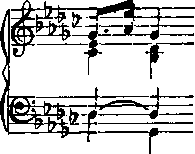168
Lectures on Modem Music

almost an obsession with Chabrier, occurs, in one form
or another, again and again in the “Preludes”, making the
impression of reminiscence unavoidable. Chabrier’s influ-
ence is likewise apparent in certain arpeggiated forms of
melodic line (based usually on the notes of secondary
seventh chords) common to both composers and in those
sudden lapses into a rather vulgar lyricism and the more
popular moods of street song and music-hall to which we
shall later have occasion to draw specific attention.
In 1915, Debussy published his two volumes of “Études”
for the piano and dedicated them “to the memory of Fred-
eric Chopin”. The inscription is significant, for it repre-
sents a conscious homage to the composer whose influence
was a chief and guiding factor in the formation of De-
bussy’s piano style.
For many musicians, Chopin’s greatness has been some-
what obscured by his rather promiscuous popularity in the
concert hall and by the flabby and spineless manner of play-
ing his music which has gradually and insidiously estab-
lished itself as a “Chopin Tradition”. The electric force
and abandon of his rhythms, the pride, nobility and martial
splendor which are the national heritage of every Pole,
have been sacrificed to an effeminate sentimentality which
obscures both the refinement and the delicacy, as well as
the essential manliness, of Chopin’s music.
We shall have to rediscover Chopin, reappreciate his
amazingly original harmonies, the individuality of his piano
More intriguing information
1. Implementation of Rule Based Algorithm for Sandhi-Vicheda Of Compound Hindi Words2. Outline of a new approach to the nature of mind
3. sycnoιogιcaι spaces
4. A Review of Kuhnian and Lakatosian “Explanations” in Economics
5. The name is absent
6. CURRENT CHALLENGES FOR AGRICULTURAL POLICY
7. The name is absent
8. The Dynamic Cost of the Draft
9. THE ECONOMICS OF COMPETITION IN HEALTH INSURANCE- THE IRISH CASE STUDY.
10. Putting Globalization and Concentration in the Agri-food Sector into Context